Physical Address
304 North Cardinal St.
Dorchester Center, MA 02124
Physical Address
304 North Cardinal St.
Dorchester Center, MA 02124
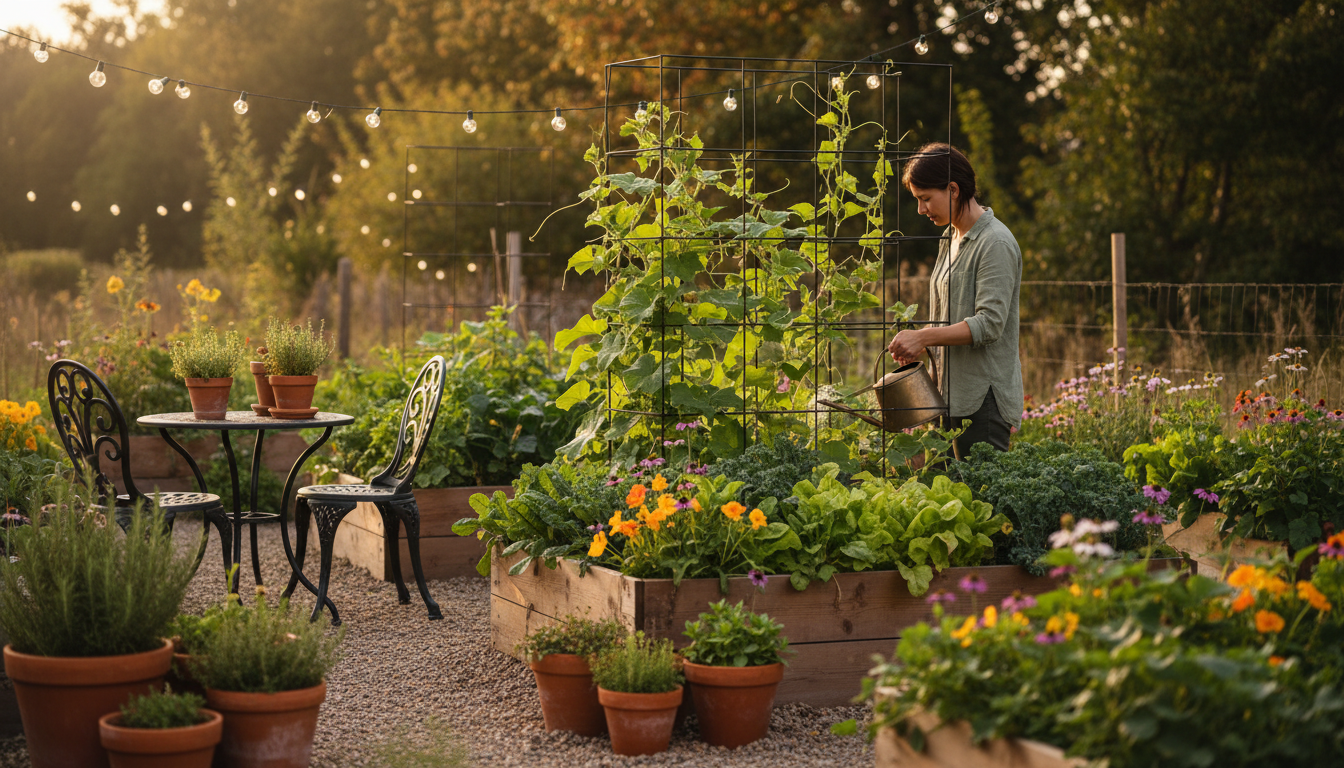
Dreaming up small garden ideas for a tiny backyard garden? This guide shows how to maximize space with a lush raised bed garden and smart vertical gardening. Learn easy layouts, what to grow in container gardening, and how to layer height with a sturdy garden trellis and chic herb planter pots. We’ll compare DIY builds vs a budget-friendly raised garden bed kit, share soil mixes using organic potting soil, and add cozy vibes with outdoor string lights. Turn every square foot into a harvest-ready haven—beautiful, productive, and totally doable!
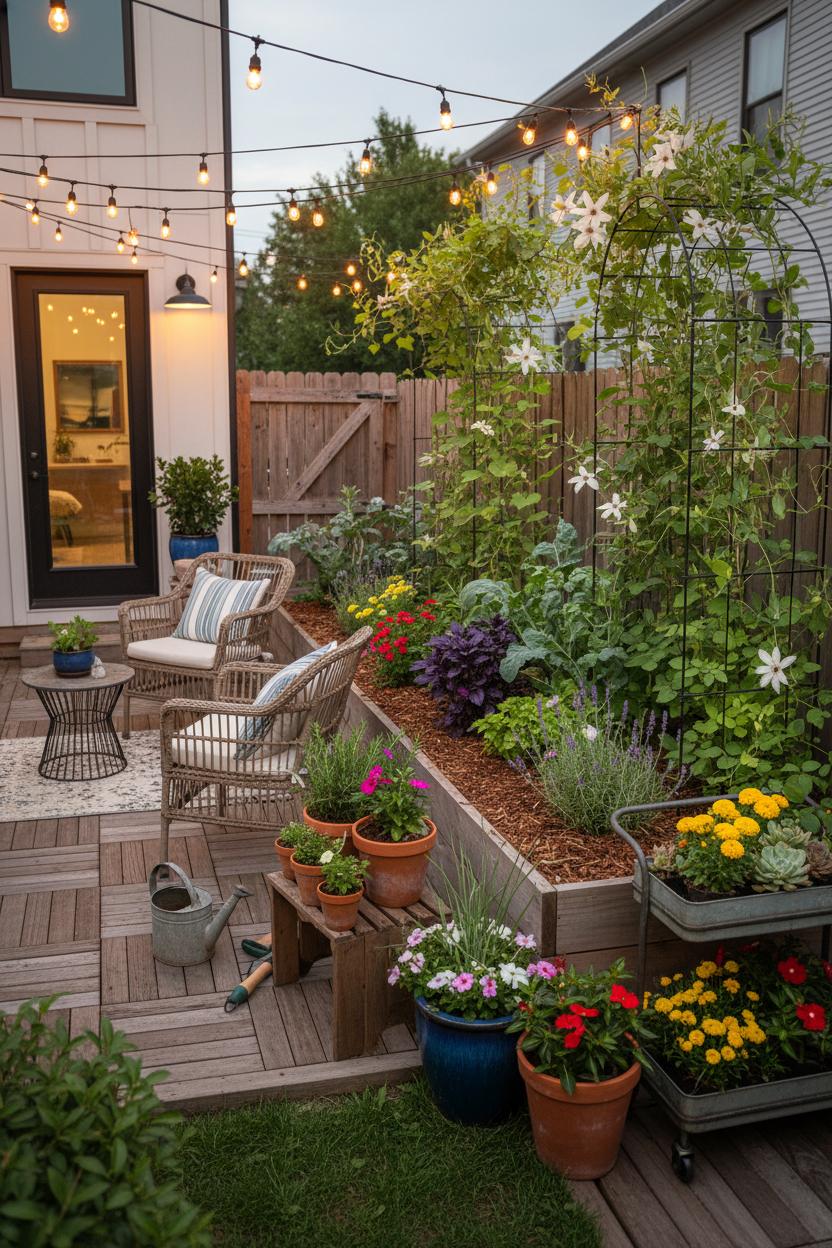
If you’re staring at a tiny patch and wondering where to begin, start by choosing one hero feature and building around it. The smartest small garden ideas focus on flow: a clear path to the door, a spot to sit with coffee, and a tidy place for plants to thrive. Spend a day watching the light move across your backyard garden; note the sunniest strip and the shadiest corner. Then sketch a simple layout with layers—tall plants or structures at the back, mid-height in the middle, and low growers or pots up front—so every inch feels intentional and lush rather than crowded.
Anchor the space with a slim raised bed garden along a sunny fence line. A raised garden bed kit is quick to assemble, looks polished, and lets you fill with rich organic potting soil for an instant boost. Keep the footprint narrow (2–3 feet wide) so you can reach from both sides, and mix edibles with ornamentals for that cottage-in-miniature vibe. Add a garden trellis on the north side of the bed and lean into vertical gardening—peas, cucumbers, pole beans, even compact melons will climb without stealing floor space. If privacy is on your wish list, train flowering vines up the trellis to create a soft green screen that doubles as a backdrop for photos.
Layer in container gardening next. Cluster herb planter pots near the back door where you’ll actually snip them for dinner, and tuck a few statement containers by the seating area for seasonal color. A rolling trough or bar-cart planter is perfect for chasing sun across the patio. Keep textures varied—glossy leaves beside feathery grasses—and repeat a couple of colors to make the whole scene feel cohesive. At dusk, drape outdoor string lights overhead to turn the smallest nook into a glow-up moment, and set a low stool or crate as a mini potting perch. Water deeply, add a mulch top-up to pots and beds, and keep a small bin of organic potting soil handy for quick refreshes. With a slim raised bed, a vertical moment, and a curated container cluster, your tiny backyard garden will feel like a layered, living room—proof that the best small garden ideas aren’t about size at all, but about smart, beautiful choices.

Start by sketching your space and the sun pattern, then think in shapes. In a small backyard garden, U- or L-shaped beds hug the edges and leave a cozy “room” in the middle for you to move, crouch, and admire. Keep each raised bed garden no wider than 3–4 feet so you can reach the center from either side, and aim for 18–24-inch paths for easy wheelbarrow swings and barefoot strolls. If you’re new to building, a modular raised garden bed kit makes layout playful—slide pieces around until your flow feels right, then anchor the corners. I love offsetting beds on a slight diagonal to create a sense of depth; it’s one of those small garden ideas that tricks the eye into seeing more square footage than you actually have.
Fill the frames with a rich base and finish with a generous layer of organic potting soil for that fluffy, root-loving texture. Plant tall crops on the north side so they don’t cast shade, and work in a garden trellis (or two) for climbers—think beans arching over a path, cucumbers cascading like green chandeliers. That’s vertical gardening doing double-duty: structure and abundance. Tuck quick picks like lettuce along the bed edges, slide strawberries into sunny corners, and corral runaway herbs in cute herb planter pots near the entry where you can snip as you walk by. Overflow crops and heat lovers do beautifully in matching containers, so blend in container gardening along the perimeter to soften edges and layer height without crowding the beds.
Finish with details that make your layout feel like an outdoor room. Mulch the pathways so they stay tidy and cool, coil a simple drip line beneath the soil surface to reduce evaporation, and string warm outdoor string lights overhead to turn evening harvests into little celebrations. Rotate crops bed to bed each season, and keep a small stepping stone inside longer beds for mid-season pruning access. With a thoughtful raised bed garden plan that mixes structure, vertical accents, and a few portable pots, your backyard garden can look lush and intentional from the very first sprout—proof that even the tiniest footprint can yield big flavor, beauty, and those daily “wow, I grew that” moments.

When you’re choosing a raised garden bed kit for a small space, start with size and shape. In tight corners or along a fence, a 3–4 ft wide bed is ideal so you can reach the center without stepping in, while lengths of 6–8 ft keep things tidy and manageable. Depth matters: 10–12 inches suits herbs, lettuce, and flowers; go 15–17 inches for tomatoes, carrots, and dahlias. If your backyard garden is especially narrow, think in layers—pair a compact raised bed garden with a slim garden trellis behind it for instant vertical gardening, or tuck a few herb planter pots at the ends for extra flavor within arm’s reach. U- or L-shaped configurations can carve out a cozy mini-plot and make harvesting feel like a stroll.
Materials set the tone and the workload. Cedar and redwood are beautiful, long-lasting, and blend easily with almost any aesthetic; powder-coated steel or corrugated metal reads modern and is wonderfully sturdy; composite options are low maintenance and resist warping. Look for kits with corner bracing and bottomless designs for drainage. Place your bed where it gets at least six hours of sun, then make sure the spot is level before you assemble—you’ll save yourself from uneven watering later. If aesthetics are part of your small garden ideas mood board, match the bed with a coordinating garden trellis, and consider how container gardening can echo the materials and colors for a pulled-together look.
For setup, lay cardboard to smother grass, then build a layered base: twigs, leaves, and coarse compost at the bottom, topped with a rich blend of compost and organic potting soil for that fluffy, root-loving texture. Water deeply to settle, mulch to retain moisture, and add a simple drip line if you can. Train cucumbers or peas up the trellis to free up square footage, and plant quick-win herbs along the edges for everyday snipping. At dusk, a strand of outdoor string lights turns your raised bed garden into pure evening magic—proof that small spaces can be wildly abundant when raised beds, vertical gardening, and container gardening all play together.
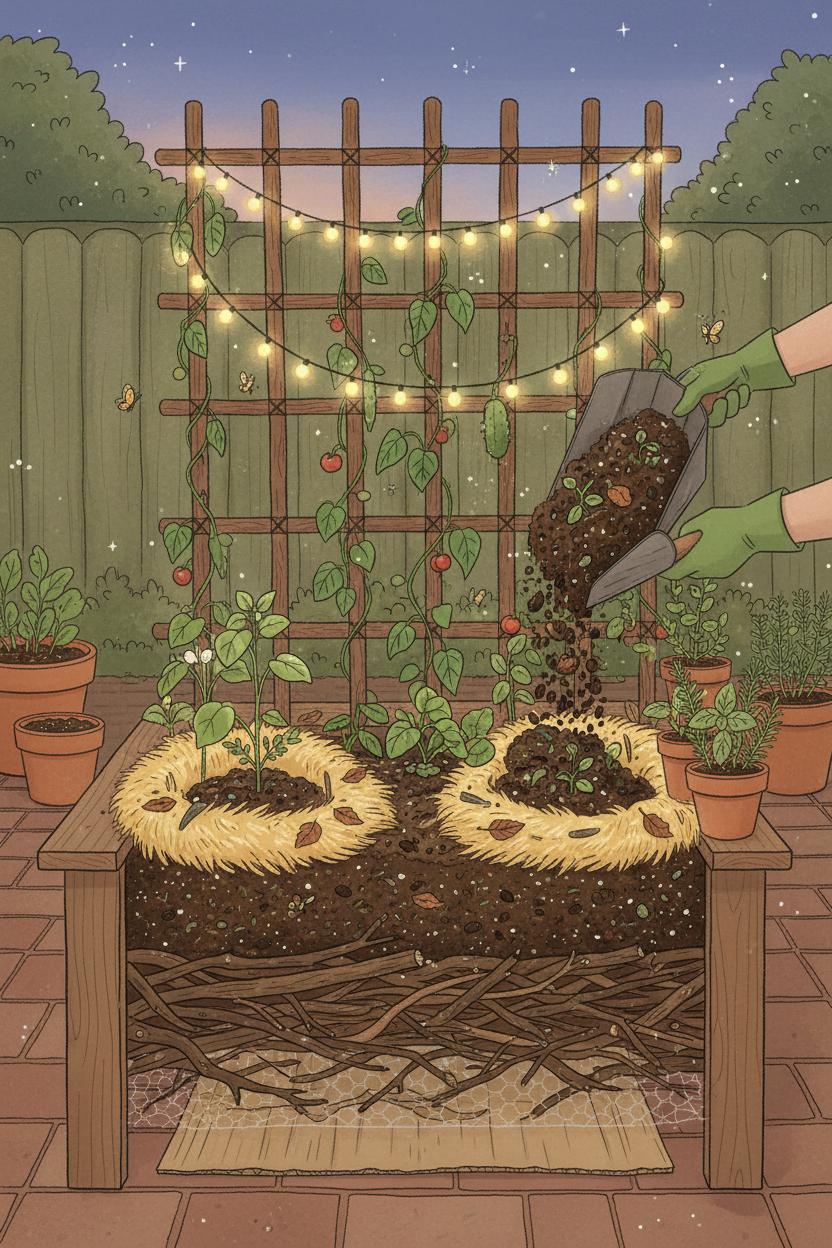
Before you plant a single seed, give your raised bed garden the good stuff it needs to thrive. I like to think of bed-filling as building a cozy layer cake: start with a flattish layer of cardboard at the bottom to smother weeds, then add chunky browns like twigs or dry stems for drainage. On top of that, pour in a generous mix of organic potting soil and finished compost—about 60/40 is a sweet spot for most veggie beds. The organic potting soil keeps things fluffy and well-drained, while compost brings in the buffet of nutrients and microbes that make plants downright jubilant. If you’re assembling a new raised garden bed kit, line the base with hardware cloth to deter burrowers, then fill to within a couple inches of the top so roots have room to stretch and you still have space for mulch.
Mulch is your quiet hero. After planting, tuck a 1–2 inch blanket of straw, shredded leaves, or fine bark around your seedlings (keeping a little donut of space around each stem). Mulch locks in moisture, keeps soil temperatures steady, and turns watering from a daily chore into a relaxed rhythm—such a win for a busy backyard garden. It also slows weeds so your small garden ideas stay lovely, not labor-intensive. As your plants take off, top-dress with another sprinkle of compost midseason, then re-cover with mulch. Near a garden trellis, where tomatoes and cucumbers climb, add a little extra compost—those vertical gardening powerhouses are hungry. If you’re growing herbs in the same space, nestle a few herb planter pots along the edges and use the same potting soil/compost mix scaled down for container gardening; it keeps flavors bold and watering predictable.
The beauty of this fill-and-mulch approach is how adaptable it is, whether you’re tucking greens into a slim side-yard bed or going tall with vines and a twinkly vibe. Once everything is mulched, string up outdoor string lights over your trellis for a soft glow that makes evening harvests feel magical. With a smart soil base, a compost boost, and a tidy mulch topper, even the tiniest plot becomes a productive, low-fuss haven—exactly the kind of small garden ideas that make a compact space feel abundant.
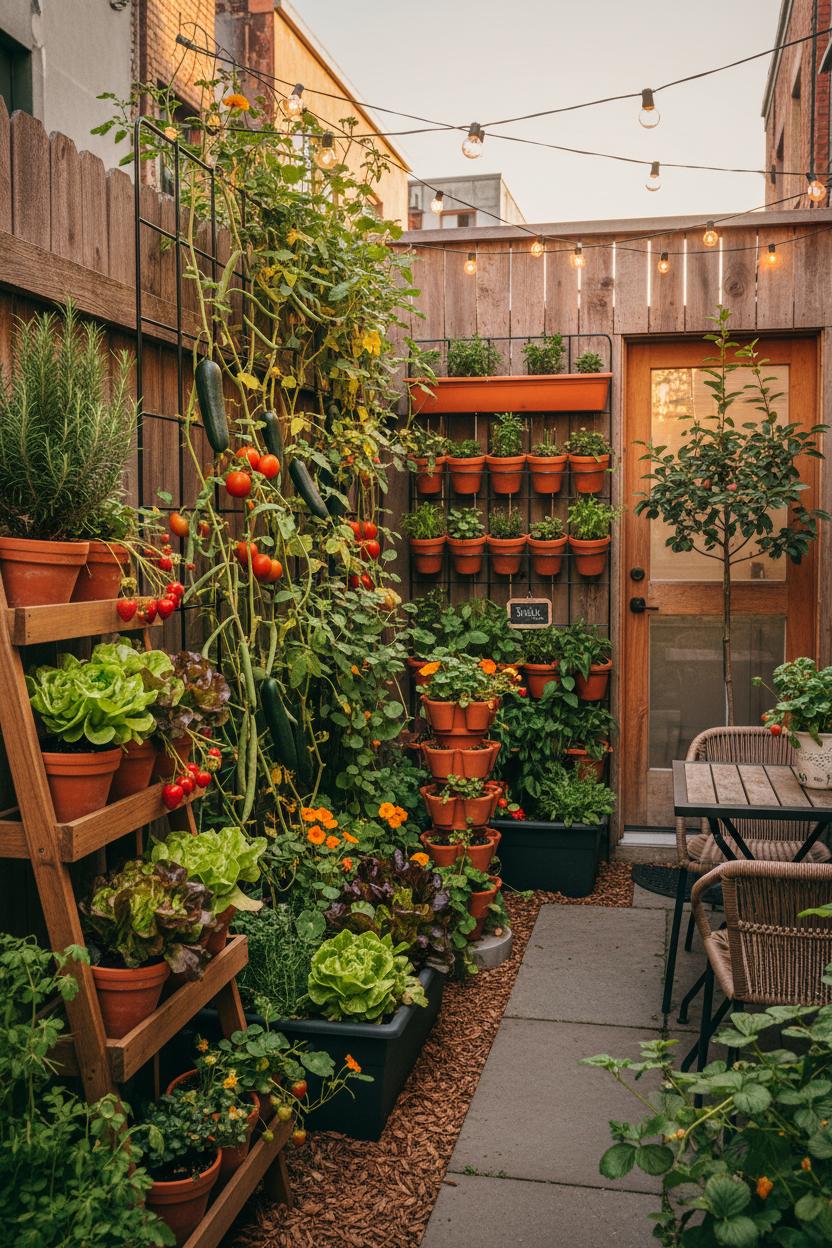
When space is tight, think up, not out. Vertical gardening turns a fence, wall, or balcony rail into a lush backdrop, freeing ground room for lounging or a slim path while multiplying your harvest. Start with a sturdy garden trellis and let peas, pole beans, cucumbers, and vining tomatoes climb skyward; the foliage creates a green screen and the fruit dangles within easy reach. Along the sunniest fence, add wall planters or a simple grid to hang herb planter pots near the kitchen door—snip basil, mint, and thyme as you pass. If you’re working with a raised bed garden, tuck a trellis at the north edge so climbers won’t shade shorter crops, or choose a raised garden bed kit with a built‑in arch for instant structure. Espalier a dwarf apple against a fence, stack strawberry towers by the patio, and weave in trailing nasturtiums for edible color. These small garden ideas keep a backyard garden feeling abundant without feeling crowded.
Container gardening shines in the vertical world, too. Ladder shelves, balcony rails, and pocket planters let you layer textures: upright rosemary, ruffled lettuces, and spilling strawberries. Use a high‑quality organic potting soil to keep containers light and well‑drained, then add a thin mulch to hold moisture. A simple drip line or self‑watering inserts can be a game changer when summer heats up. Think composition as much as cultivation—repeat a palette of greens and soft florals up the wall, then twine a few vines through the structure to soften edges. At dusk, zigzag outdoor string lights overhead to frame the verticals and make your little oasis glow. Whether you’re styling a petite patio or carving out a corner by the shed, vertical gardening plus containers delivers impact and harvest in the slimmest footprint. Mix wall planters with a trellis-topped bed, refresh herb planter pots seasonally, and keep a few movable containers ready to shuffle with the light. With a couple of smart supports and the right soil, your small backyard can feel layered, lush, and endlessly productive.

When space is tight, think bite-sized. Compact edibles are the secret sauce of small garden ideas, letting you tuck flavor into every corner of a backyard garden without it feeling crowded. If you’re starting from scratch, a raised garden bed kit makes it easy to frame a neat, productive plot you can reach from all sides, and it looks so polished next to a patio. Fill containers with fresh, organic potting soil and layer your beds with rich compost, then keep your most-used herbs near the kitchen door for quick snips while dinner simmers. I love a mix of textures and heights—leafy greens nestled at the edges, bushy fruiting plants in the middle, and climbers reaching up to catch the sun.
For a raised bed garden that produces like a mini market, choose compact varieties: bush tomatoes and patio eggplants, dwarf bell peppers, snack cucumbers bred for containers, and short-root carrots and radishes that mature fast for easy succession planting. Cut-and-come-again lettuces, spinach, and baby kale can carpet the front of a bed and refill your salad bowl week after week. Tuck strawberries along the borders, and use herb planter pots for basil, thyme, and chives so you can shuffle them into the sunniest spots as the seasons shift. If you’re embracing container gardening on a balcony or deck, group pots by watering needs, and think in layers—tall pots in back, spillers like nasturtiums in front—for a lush, edible bouquet.
Vertical gardening is where the magic happens. A sturdy garden trellis turns a single square of soil into a green wall of snap peas in spring and pole beans or cucumbers by midsummer; train vines with soft ties and harvest at eye level like a living pantry. Try mini winter squash such as ‘Honey Nut’ on an arch, or let indeterminate tomatoes climb a string trellis and prune lightly to keep the airflow sweet. Slip a narrow pathway between trellised rows so you can brush past fragrant tomatoes at dusk, then flick on outdoor string lights for a cozy glow that makes evening harvests feel like a backyard bistro. Small space, big flavor—stack it up and snack it all season.
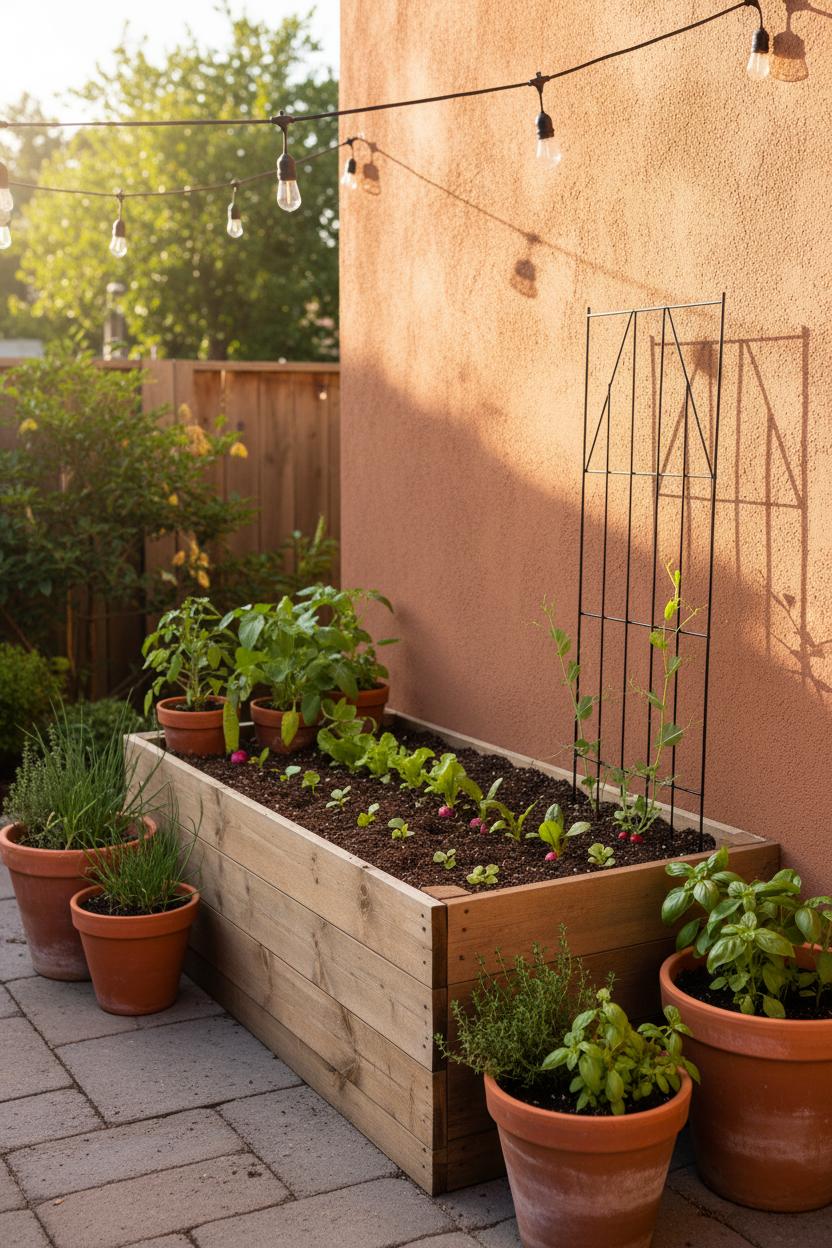
Seasons move fast in a small backyard garden, so a little rhythm goes a long way. In early spring, wake up your raised bed garden by clearing spent stems, pulling winter weeds, and fluffing the top few inches with fresh compost. If your soil level settled, top it off with organic potting soil to give seedlings a nutrient-rich start. A compact raised garden bed kit is perfect for tight corners or patios, and once it’s assembled, think vertical right away: a slim garden trellis at the north side lets peas and later cucumbers climb without stealing precious square footage. For tender starts, tuck in a mix of cool-season greens, herbs, and radishes first, then hold your warm-season seedlings in container gardening setups near the sunniest wall until night temps are stable.
Crop rotation is the secret sauce to keeping a tiny plot productive without burnout. Even in one small bed, rotate plant families season by season: follow hungry fruiting crops like tomatoes and peppers with nitrogen-fixing beans, trail those with leafy greens, and end the year with roots and alliums. This simple loop helps prevent soil-borne diseases and balances nutrients naturally. If you’re growing up as much as out with vertical gardening, train tomatoes or pole beans on that garden trellis and let sprawling squash spill into a separate container; keeping heavy feeders mobile makes swapping spots next year easier. Park perennials like thyme and chives in herb planter pots so they don’t hijack your rotation, and slide them around the patio as the sun shifts. Between crops, sow quick cover crops or mulch with shredded leaves to protect the soil and invite worms to do their quiet magic.
With summer heat, water deeply in the morning, mulch to keep roots cool, and snip regularly to encourage new growth. As fall approaches, clear fading vines, add another light layer of organic potting soil, and tuck in autumn greens where tomatoes once were. In winter, brush off snow load from trellises, empty cracked containers, and sketch next year’s plan while your outdoor string lights twinkle over the sleeping bed. These small garden ideas—rotate smart, grow up, and rest what you can—turn a tiny space into a year-round, beautifully efficient backyard garden.
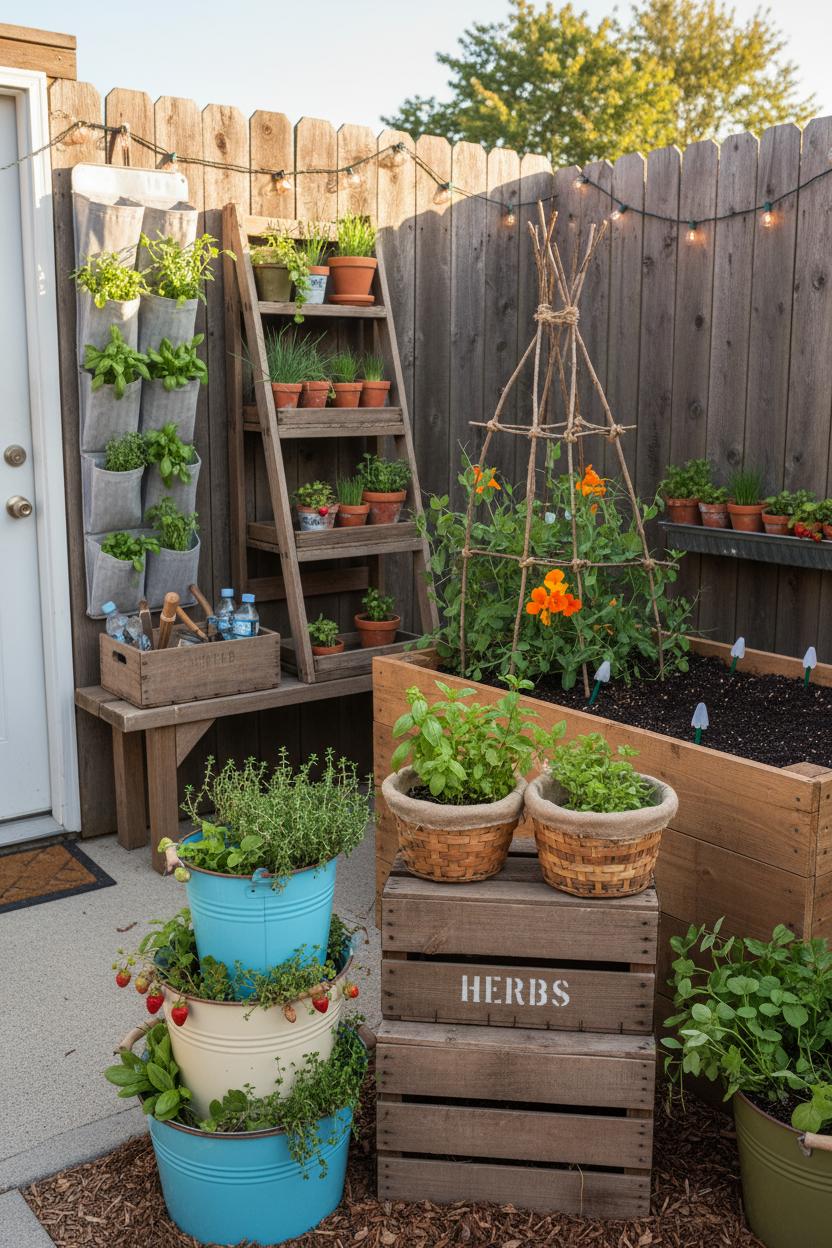
When your space (and budget) are small, the most charming garden upgrades are often the simplest. Start with container gardening using what you already have: paint old buckets, line thrifted baskets, or stack wooden crates for instant layered height. A trio of herb planter pots on the steps looks Pinterest-pretty and keeps dinner flavors within reach. Choose organic potting soil so your containers stay light, airy, and productive, then tuck in a mix of leafy greens, strawberries, and trailing thyme. For vertical gardening on a dime, hang a shoe organizer by the back door, mount a salvaged pallet to the fence, or lean a narrow ladder shelf and fill it with mini pots. These small garden ideas stretch every inch while turning forgotten corners into tiny edible vignettes.
If you’re dreaming of a raised bed garden without a big spend, think modular and compact. A simple raised garden bed kit can snap together in an afternoon, or you can DIY with cedar offcuts, cinder blocks, or a repurposed stock tank. Layer cardboard to smother weeds, then fill with a blend of compost and organic potting soil for a fertile start. Add a garden trellis at the back—branches lashed with twine, a metal panel, or a bamboo fan—to lift peas, cucumbers, or nasturtiums and save precious ground space. This kind of vertical gardening adds privacy, frames a cozy nook, and keeps pathways open in a busy backyard garden. Plant taller crops near the trellis, midsize herbs in the middle, and low growers up front so every plant gets the sun it deserves.
Finish with budget-friendly charm that doubles as function. Drape outdoor string lights along the fence to define your “garden room” and extend evenings outside. Slip drip spikes into soda bottles for slow watering, mulch with shredded leaves, and stash a few tools in a weathered crate under the bench. Upcycle gutters into a slim strawberry rail, or turn a pallet into a wall of basil, mint, and chives so your herb planter pots can migrate to the table as a fragrant centerpiece. With layered heights, portable containers, and a few clever trellises, even the tiniest plot feels polished, productive, and joyfully you.
From tiered trellises to snug cedar frames, these small garden ideas prove your backyard garden can bloom big in a tiny footprint. Mix a raised bed garden for easy tending with vertical gardening to climb skyward, and tuck herbs into container gardening for flexible color and flavor. Start with sun, good soil, and a simple plan, then add pretty pathways and a comfy perch. Pour a cup of tea, step outside, and let your pocket paradise grow—one vine, one seedling, one peaceful moment at a time.